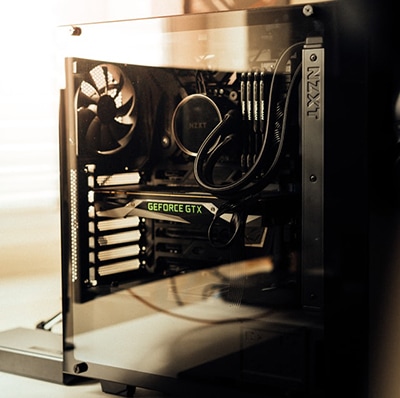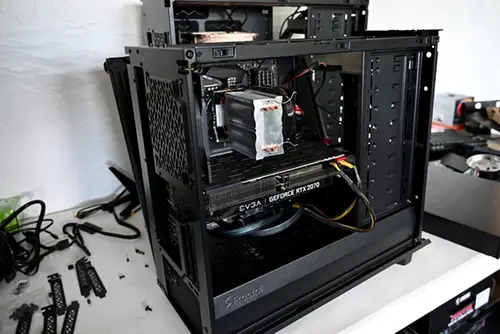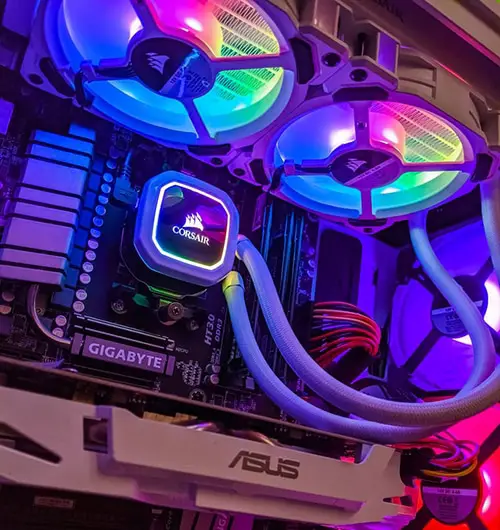
Are you building a new computer and confused between Full Tower Vs Mid Tower chassis? I don’t blame you, it can be daunting, especially when there are a ton of options. But here’s the lowdown:
Full tower offers bigger space for components and better cooling but takes up a lot of space.
Mid tower has a smaller footprint but could be tricky to cool and has limited space.
Of course, just like any other PC component, choosing between one is not this simple. There are several factors you need to consider before taking the plunge and buying one or another. Personally, I have a compact build to accompany my TV in the lounge and a bigger one in my gaming room. So let’s pit Mid tower vs. Full Tower, and compare all the different aspects that should be considered, and finally get the case that’s made for you.
Contents
A Mid tower casing is smaller when compared to a full tower. This results in lesser compatibility with motherboard sizes, fewer PCI-E expansion slots, and less room for more hard drives. There is also less room for larger radiators and additional cooling fans. But all the sacrifice do have its benefits; mid- towers are generally lighter and easier to carry, plus they are also light on the wallet. If you’re simply building a gaming machine, a Middle Tower case would be enough for you unless you want to go for top-of-the-line specs.
Here’s a handy chart that will make it easier to understand the major differences between a Full and Mid tower. Keep in mind these are just ballpark numbers and there will always be chassis that askew the dimensions for style.
| Full Tower Case | Mid Tower Case | |
| Size | 21-26 inches | Approx. 18 inches |
| Motherboard | Mini-ITX, Micro-ATC, ATX, E-ATX, XL-ATX | Mini-ITX, Micro-ATX, ATX |
| PCIe Slots | 8-10 | 6-9 |
| Drive Bays | 9-15 | 5-10 |
| Radiator Support | 480 mm | 360 mm |
| Fan Mounts | 10-15 | 6-9 |
| Graphic Cards | 2-4 | 1-2 |

There are several key differences between a Full Tower chassis and a Mid tower PC Case. These are important for a proper purchase that is going to last you a couple of builds. Let’s dive a bit deeper and discover which tower size is most suitable for you.
The case size is perhaps the biggest and most noticeable difference between a full tower and a Mid Tower PC Case. Naturally, the bigger the size, the more components can fit inside, and that’s exactly what a full tower is capable of.
A Mid Tower Case is around 18 inches tall and long. It is large enough to comfortably fit a full gaming rig inside and still be easy to carry around. Sure, you may not get a ton of drive bays to install additional storage but you will have plenty to house all your steam games (probably 25, if you have Call of Duty installed). The NZXT H510 is a good example of a Mid tower case that doesn’t cost a ton.
A Full Tower case is a giant, no really, compare it to a Mid Tower Case, and it’s practically a building. They can go upwards of 20 inches in both height and length, but that’s because they are designed to house the biggest components. With large real estate comes the possibility of installing multiple, graphic cards many drives, and even full-on work cooling systems inside the chassis.
If you’re going to build a workstation, a Full tower PC Case is the best option. It offers numerous opportunities for expansion, as well as better compatibility and connectivity. The Corsair Obsidian 750D is a no-nonsense, straight-to-business-looking Full tower chassis. I’m going to be using this for my next build because I’m an adult with a home office now. A Full Tower Case like The Obsidian will not only house my video editing rig but also look professional in Zoom calls.Noise Levels - The Full Tower PC Case can have multiple fans, so they won’t have to do the heavy lifting when it comes to keeping the temperature down. If you have a proper push and pull arrangement, your fans won’t have to spend a lot to maintain a cooler temperature.
This can result in a quieter overall experience. However, some cases do come with noise dampening solutions, even in Mid Tower Case category. This means you can enjoy raiding in World of Warcraft the whole night without disturbing your spouse (you also have to keep quiet). The Fractal Design Define S is a perfect example of a quiet Mid tower case.
The motherboard support is what will force you to go with Full Tower PC Cases if you are a working professional that needs power. Sure, any Mid Tower Case can easily fit in an ATX motherboard, so if you’re making a normal or gaming build, they would be perfectly adequate.
However, if you’re going for an E-ATX board that is wider than 10.7 then you’ll run into trouble when using a Mid Tower PC Case. You’ll have even more problems when trying to fit in an XL-ATX board inside a Mid Tower Case when you’re making a beastly AMD Threadripper system. So, generally speaking, if you are making a work-based rig, a full tower would make things easier.
A general rule of thumb is to select the components first and then move on to purchase the chassis. Then select the motherboard you require, and then choose the chassis size later.
Anyone who does video editing knows how fast storage space gets eaten up. Especially if you’re using SSDs, you already have a limited amount of space. Even if you are just a gamer, games these days take up a ton of storage space.
For example, The Elder Scrolls V: Skyrim was below 10 GB at launch. The Size grew up to 12 GB after the DLC. In comparison, Grand Theft Auto 5 is 72 GB, while Call of Duty Black Ops Cold War took 175 GB of storage space. Thankfully, the price of standard HDDs is quite low these days, so you can get cheap storage. However, you’ll still need to install those drives in the drive bay.
If you’re a casual gamer or simply don’t require a lot of storage space or enhanced capabilities (like a Blu-ray drive), you can make do easily with a Mid Tower PC Case. However, if your storage needs are bigger, Full Tower Cases are the way to go. Video editing, photoshopping, and even storing RAW files from your DSLR is going to eat up a lot of storage space. I’m not even considering huge AutoCAD drawings if you’re an engineer or 3D models if you’re an architect. Professionals require a professional solution, and that can only be provided with Full Tower PC cases.
Most PC cases also come with SSD side mounts, so you don’t have to take up precious 3.5” drive bay space just install them. Mid Tower PC Cases have 1 to 3 SSD drive slots, while full towers go anywhere from 2 to 6.
Even if you go with a Mid Tower case, you can always buy external hard drives that you can just plug and play. Personally, I recommend that you always have a backup on an external hard drive in case of an emergency. With the prices at an all-time low, USB 3.0 external hard drives are faster and more reliable at an affordable price.
The PCIe expansion slots are one area where Full Tower Cases have the full advantage. An additional slot may not sound like a big deal, but it can be a huge bonus if you want to install multiple GPUs. If you are working with 3D models or doing professional 3D rendering, you’ll need multiple graphic cards to support that kind of workload. Additional PCIe slots will not only allow you to space out your graphic cards for better cooling but also help you optimize airflow.

Ideally, you’d want the internal temperature of your computer to be cool. However, that’s not the case most of the time, no pun intended. Thankfully, you can easily add additional fans to the chassis. Both Full Tower and Mid Tower cases offer numerous fan mounts that can drastically help increase airflow. The more air that passes through the case, the more heat gets dissipated, and the components run cooler.
PC components work best when they are cooler. So having good airflow is a must if you want to use your computer to its full efficiency and power. Naturally, the Full Tower PC Case has a larger area, as it has more fan mounts. However, you don’t need to worry about the Mid Tower Cases lacking proper airflow, they are just as good at keeping your components cooler.
Size Affects Cooling - The larger the size, the easier it will be for the air to pass through. So Full Tower Cases will be better at maintaining a healthy airflow because no other components will be blocking passages. The components are spaced further apart from each other and help maintain a healthy temperature. This also gives ample room for the CPU cooler as well as GPU fans to work effectively. A larger motherboard naturally has more space between the heat sinks, the graphic cards, and the CPU cooler, so they won’t disrupt the airflow.
Liquid Cooling – A larger case will help if you want liquid cooling in your PC. Even if you plan to liquid cool later down the road, a larger case will make it easy to install a cooling system. Liquid cooling systems are available in two configurations; closed-loop and open loop. If you opt for an open-loop, you’ll need to do regular maintenance, which again is easier on a Full Tower Case. More space also means more options for bigger radiators, and more places to easily mount them.
Before you spend your hard-earned money on a chassis, you should go through a general checklist to determine which size will be best for you. Here are a few questions that’ll help you narrow down your choice:
Space Inside – You won’t need a lot of space inside the tower cases if you take your time. However, if you are swapping hardware often, a larger case would be the way to go.
Future Upgrades – You don’t need to get a new chassis every time you upgrade your PC. A good chassis can last multiple years. If you want to easily upgrade your PC, a larger case would be best as it allows space for easy access.
Personal Space – Living in a dorm or just buying your own house? Cramped spaces are not great for a large PC chassis, Mid Tower Cases would be great for those. However, if space is no issue, you are better off with a Full Tower PC Case.
Desk Space and Durability – Yes, this is often overlooked. A bigger chassis is going to weigh a lot more than a smaller one. It’s usually made with metal and alloys, so the weight adds up. I’ve seen many flimsy desks buckle under the weight of a Full Tower PC Case. So, either get a sturdier desk or go for Mid Tower Cases.
Climate – Living near the equator? You’ll need better off with cooling than a Full Tower Case can offer.
Storage – If you require a ton of storage for your PC, you’ll need to have multiple drive bays to install them. Again, a Full Tower Case will have those.
Add-on Cards – Want to install additional add-ons on the board? Maybe a beefy soundcard? You can do so on Mid Towers, but what if you require more stuff? Like WiFi or even an additional NVME SSD? You guessed it, a Full Tower Case would do.
Front Panel – A larger case will have a bigger front panel. You can easily install CD/DVD drives, fan controllers, and even LCDs that display stats. The bigger the panel, the bigger the customization potential.
Portability – Smaller Mid Towers would be easier to move around.
GPU – Need one GPU? Mid Tower Cases can handle two. Need even more? Well, get a Full Tower Case for overkills.
If you have the space, the funds, and can lift heavy objects, simply go with a Full Tower Case and call it a day. However, if you like portability, don’t have extra space, and like the small form factor aesthetics, get a mid tower.
I hope this Mid Tower vs. Full Tower Cases comparison fight helped you nail down the best chassis for you. Happy hunting!
